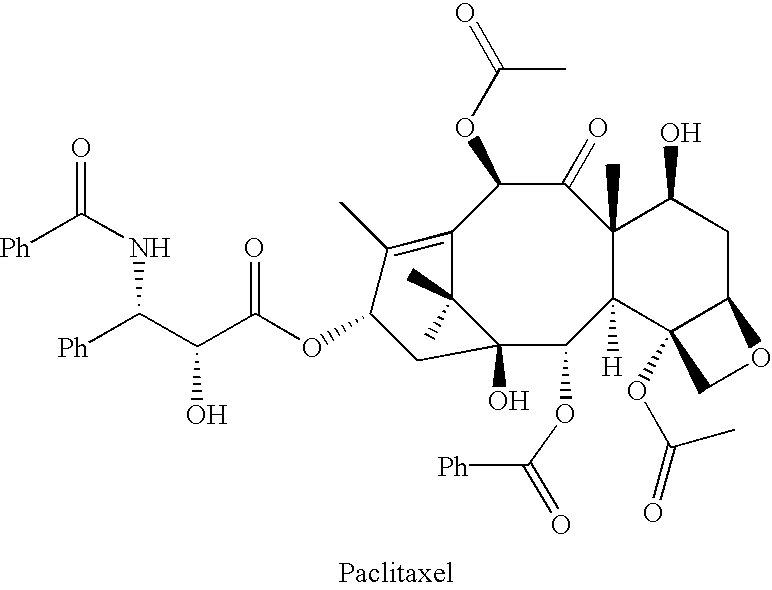Semi-synthesis of a protected baccatin III compound
a technology of baccatin and iii, which is applied in the field of semi-synthesis of protected baccatin iii compounds, can solve the problems of limited availability of paclitaxel and its derivatives, difficult extraction, and high cost of tile processes, and achieves simple, high yield, and low cost
- Summary
- Abstract
- Description
- Claims
- Application Information
AI Technical Summary
Benefits of technology
Problems solved by technology
Method used
Image
Examples
example 1
[0046] Preparation of Compounds of Formula II
[0047] (a) Preparation of 9-Dihydro-13-Acetyl-7-t-Butyl-Diphenylsilyl-Bacc- atin III
[0048] In one procedure for making Compounds of Formula II, 9-dihydro-13-acetylbaccatin III, (63 mg; 0.1 mmol, 1 eq) was dissolved in 1 mL of dimethylformamide, to which imidazole (107 mg; 1.57 mmol; 15,7 eq) was added and the solution was stirred. t-Butyldiphenyisilylchloride (350 uL; 1.35 mmol) was added to this reaction mixture dropwise, with stirring. After being stirred for 18 hours, and the work up consisted of adding ethyl acetate, washing the organic layer with water and brine, dring over anhydrous sodium sulphate, and evaporation. The residue was subjected to silica gel chromatography with hexane and dichloromethane to obtain a 60% yield of Compound 2;9-dihydro-13-acetyl-7-t-butyldiphenylsil- yl-baccatin III. 10
[0049] (b) Preparation of 9-Dihydro-13-Acetyl-7-t-Butyl-Dimethylsilyl-Bacc- atin III
[0050] A solution of 9-dihydro-13-acetylbaccatin III (...
example 2
[0054] Preparation of Compounds of Formula 3
[0055] (a) Preparation of 13-acetyl-7-t-butyldiphenyisilyl-baccatin III
[0056] One compound of Formula II, 9-dihydro-13-acetyl-7-t-butyldiphenylsi- lyl-baccatin III (6.0 mg) was dissolved in acetone (1.0 mL) and stirred at room temperature. To this was added 50 .mu.L of Jones' reagent, prepared by adding 200 mg of chromium trioxide in a mixture of conc. H.sub.2SO.sub.4 and water (1 mL; 3:7 v / v), and stirred at room temperature for 30 mins. The resulting solution was worked-up by treating the reaction mixture with potassium bicarbonate and anhydrous magnesum sulphate. The crude material was then chromatographed on silica gel to obtain 5.0 mg of 13-acetyl-7-t-butyldiphenyl-silyl-baccatin III, depicted as Compound 3. 13
[0057] (b) Preparation of13-acetyl-7-t-butyldiphenylsilyl-baccatin III
[0058] 9-Dihydro-13-acetyl-7-t-butyldiphenylsilyl-baccatin III (0.095 g; 0.109 mmol) was dissolved in acetone (16 ml) and was stirred at 25.degree. C. To this...
example 3
[0059] Preparation of Compounds of Formula 4
[0060] (a) Preparation of 7-tert-butyldiphenylsilylbaccatin III
[0061] One of the Compounds of Formula III, 13-acetyl-7-t-butyldiphenyl-si- lyl-baccatin III(5.0 mg) was dissolved in a polar donor solvent such as tetrahydrofuran (500 .mu.L). After cooling the reaction mixture to -78.degree. C., 50 .mu.L of 1.4 M methyl lithium in ether was added and the solution stirred for 1.5 hours. The reaction mixture was then quenched with aqueous sodium acetate and worked-up with ethyl acetate. The crude reaction mixture was subjected to HPLC and three compounds were isolated. The desired product, 7-tert-butyldiphenylsilylbaccatin III, depicted as Compound 4, was purified using preparative HPLC (RP-18 column) gradient (100 min; 25% MeCN to 100% MeCN) with a retention time of 81 min. 14
[0062] (b) Preparation of 7-t-butyldiphenylsilyl-baccatin III
[0063] 13-Acetyl-7-t-butyldiphenylsilyl-baccatin III (0.080 g; 0.092 mmol) was dissolved in tetrahydrofuran (...
PUM
 Login to View More
Login to View More Abstract
Description
Claims
Application Information
 Login to View More
Login to View More - Generate Ideas
- Intellectual Property
- Life Sciences
- Materials
- Tech Scout
- Unparalleled Data Quality
- Higher Quality Content
- 60% Fewer Hallucinations
Browse by: Latest US Patents, China's latest patents, Technical Efficacy Thesaurus, Application Domain, Technology Topic, Popular Technical Reports.
© 2025 PatSnap. All rights reserved.Legal|Privacy policy|Modern Slavery Act Transparency Statement|Sitemap|About US| Contact US: help@patsnap.com



